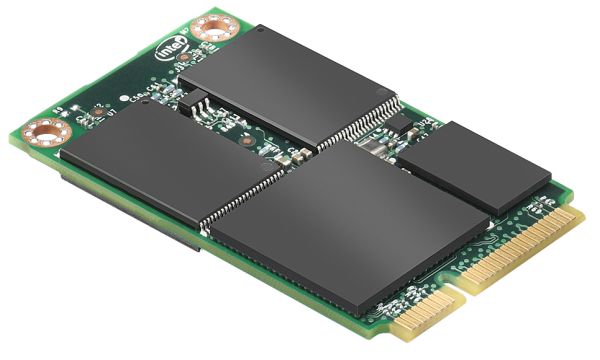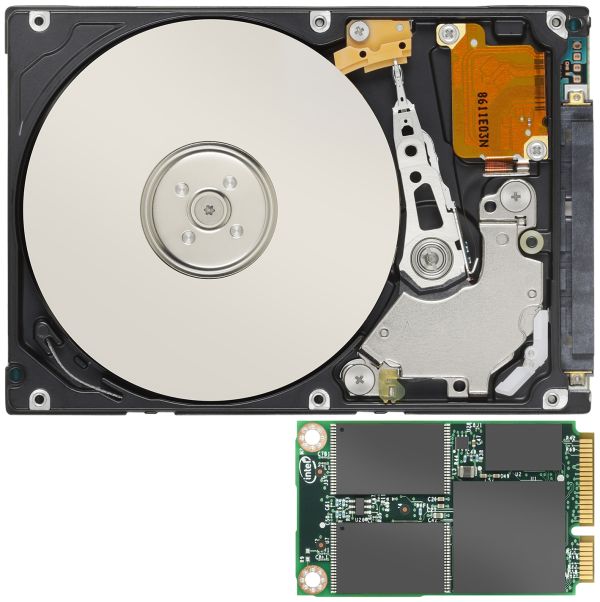Intel's SSD 310: G2 Performance in an mSATA Form Factor
by Anand Lal Shimpi on December 29, 2010 12:22 PM EST- Posted in
- Storage
- SSDs
- Intel
- Intel SSD 310
Although not quite the Intel SSD announcement we were expecting in Q4, today Intel unveiled its first mSATA SSD: the Intel SSD 310.
Based on the 34nm Intel X25-M G2 controller, the 310 will be available in both 40GB and 80GB capacities. The 80GB version should perform a bit slower than an 80GB X25-M G2 while the 40GB version will perform like a 40GB X25-V.
| Intel SSD 310 Comparison | |||||
| Intel SSD 310 | Intel X25-M G2 (34nm) | Intel X25-V (34nm) | |||
| Codename | Soda Creek | Postville | Postville | ||
| Capacities | 40/80GB | 80/160GB | 40GB | ||
| NAND | IMFT 34nm MLC | IMFT 34nm MLC | IMFT 34nm MLC | ||
| Sequential Performance Read/Write |
Up to 200/70MB/s (80GB) Up to 170/35MB/s (40GB) |
Up to 250/100 MB/s | Up to 170/35MB/s | ||
| Random 4KB Performance Read/Write |
Up to 35K/6.6K IOPS (80GB) Up to 25K/2.5K (40GB) |
Up to 35K/8.6K IOPS | Up to 25K/2.5K (40GB) | ||
| Typical Power Consumption Active/Idle | 150mW/75mW | 150mW/75mW | 150mW/75mW | ||
| Size | 50.8mm x 29.85 mm x 4.85 mm | 100.5mm x 69.9 mm x 7mm or 9.5mm | 100.5mm x 69.9 mm x 7mm or 9.5mm | ||
The 310 isn’t about performance, rather form factor. The SSD in Apple’s new MacBook Air is just the beginning - OEMs are beginning to shed the limits of traditional hard drive form factors as SSDs don’t need to house a circular platter.
The mSATA interface is physically a mini PCIe connector (similar to what you’d see with a WiFi card in a notebook) but electrically SATA. The result is something very compact.
The full sized mSATA 310 measures 50.8mm x 29.85mm and is less than 4.85mm thick. Total weight? Less than 10 grams.
The Intel SSD 310 is OEM only at this point. Lenovo has already announced it will offer the 310 in ThinkPads in the future, while DRS Technologies will show off a tablet PC next month with the 310 inside. The 40GB drive is priced at $99 while the 80GB version will run you $179 in 1000 unit quantities.
As for the rest of Intel’s SSD updated lineup? While internal roadmaps showed a Q4 release for the 3rd generation X25-M based on 25nm NAND, that product is obviously delayed. We’re also hearing that new SandForce drives are still months away so those of you eagerly waiting for new drives at the high end will have to wait a bit longer.












52 Comments
View All Comments
vectorm12 - Thursday, December 30, 2010 - link
They better make sure it's as easy to upgrade one of these as with a traditional HDD in most notebooks. I still remember the nightmare it was getting access to the small boot SSD in my old eeePC 901.As for 40GB boot drive I feel it's a little too puny as you're gonna want to run most of your software off of it and not just your OS. Currently the smallest SSD I've managed to squeeze my mobile software library + OS is on a 120GB drive and that's with about 30GB to spare.
One of these small formfactor SSDs in the 120GB capacity range + a 2,5" HDD for files would be a really great setup especially for a CULV notebook where you have to suffer less powerful hardware.
If ASUS releases a followup to my current UL35JC with a combo like that I'm gonna be buying a new machine the day it's available here in Sweden.
sinned43 - Thursday, December 30, 2010 - link
Why not show mm and inches when giving specs? Isn't anyone else making the next generation SSD's? Looks like Intel is holding all the cards. Will Intel have new motherboards to handle the forthcoming advances?taltamir - Thursday, December 30, 2010 - link
is that a 3.5", 2.5", or 1.8" HDD in the picture being compared to the 310?JackNSally - Thursday, December 30, 2010 - link
Looks like a 2.5" to metaltamir - Thursday, December 30, 2010 - link
thanks, I found the exact same picture on another website and it said 2.5" there.Scholzpdx - Sunday, January 2, 2011 - link
Would I be able to put this in an EeePC 900? It looks like the same form factor...Johnmcl7 - Sunday, January 2, 2011 - link
The Macbook Air is not the beginning at all because as usual Apple are quite a bit behind Sony on this. Their older Z series squeezed a pair of Samsung uSATA 128GB SSDs in RAID 0 for the 256GB SSD option despite the machine being a lightweight 13in model. The current Z series goes one step further by offering a choice of four SSDs in RAID 0 still in a lightweight 13in chassis. Sony very much realise the potential from compact SSDs and have made some pretty impressive storage solutions in small spaces.John
solipsism - Sunday, January 2, 2011 - link
1) As previously mentioned neither Apple nor AnandTech stated that Apple was the first to remove the casing from the SSD to save space, yet I have a feeling they will be the ones that will do it so extensively that others will follow.2) The Sony Z does NOT use the mini-PCIe connector for its SSD and the card is considerably larger than what Apple uses, so Sony was no pioneer there. In fact, they had the same form factor as the 2.5” HDDs, just thinner.
3) I know Dell Mini 9, at least, used this exact technique. The difference is they were very poor PATA SSDS of low capacity, designed to be cheap over everything else. If anyone gets credit for it would whomever made those those cards.
Johnmcl7 - Monday, January 3, 2011 - link
1) Actually it does, it's on the first page:" The SSD in Apple’s new MacBook Air is just the beginning"
2) I never said Sony were using the mini-PCIe connector however they were clearly the first to be using multiple SSDs in spaces other companies had just one. They weren't just using stripped 2.5in drives as those simply wouldn't fit, they were using one of Samsung's custom form factors named uSATA. If Sony aren't the pioneer, perhaps you can point to another company who have been using multiple SSDs in ultralight laptops where rivals have had just one? Also even stranger that you say that Apple are going to be the ones that 'will do it' despite admitting other companies have been doing it for years, short of making a time machine and going back in time Apple are far, far too late to pioneer this type of technology. Admittedly that probably won't stop them 'pioneering the technology' (!) when even AT give them credit for it when they're the usual few years late.
John
Hrel - Sunday, January 2, 2011 - link
SSD's have to hit a dollar/GB AT LEAST. I mean come on, hard drives get down to 10 cents/GB. I know they're more expensive but realistically prices still need to drop a lot to be viable for the mainstream.